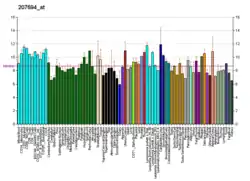POU3F4
POU domain, class 3, transcription factor 4 is a protein that in humans is encoded by the POU3F4 gene found on the X chromosome.[4][5][6]
POU3F4 is involved in the patterning of the neural tube and both the paraventricular and supraoptic nuclei of the hypothalamus in the developing embryo.[7] During development, POU3F4 is also expressed in the mesenchyme of the periotic bone surrounding the inner ear.[8] A “knockout” mice model displayed that alteration to the POU3F4 gene interrupted this mesenchymal cell differentiation in the superior semicircular canal. The deformities observed in mice were similar to those in humans with X-linked non-syndromic deafness (DFN-3).[9]
Clinical significance
Genetic testing on various persons has confirmed that mutations of the POU3F4 gene cause X-linked non-syndromic deafness (DFN-3).[10] These known mutations include:
- Missense mutation causing the substitution of amino acid glycine for glutamic acid at position 216[11]
- A deletion of the POU3F4 gene and 530 more kilobases upstream[12]
- An amino acid substitution of serine for leucine (S228L) in POU3F4[12]
- Frameshift truncation and extension mutations at the POU3F4 C-terminus[13]
Physical anomalies caused by POU3F4 mutations that have been recognized by high resolution computed tomography (HRCT) and magnetic resonance imaging (MRI) include absence of the central axis of the cochlea, an abnormally wide lateral internal auditory canal and a thickened stapes footplate. These anomalies are associated with X-linked non-syndromic deafness.[14]
References
- GRCh38: Ensembl release 89: ENSG00000196767 - Ensembl, May 2017
- "Human PubMed Reference:". National Center for Biotechnology Information, U.S. National Library of Medicine.
- "Mouse PubMed Reference:". National Center for Biotechnology Information, U.S. National Library of Medicine.
- Douville PJ, Atanasoski S, Tobler A, Fontana A, Schwab ME (Mar 1994). "The brain-specific POU-box gene Brn4 is a sex-linked transcription factor located on the human and mouse X chromosomes". Mammalian Genome. 5 (3): 180–2. doi:10.1007/BF00352353. PMID 7911044.
- Bitner-Glindzicz M, Turnpenny P, Höglund P, Kääriäinen H, Sankila EM, van der Maarel SM, de Kok YJ, Ropers HH, Cremers FP, Pembrey M (Aug 1995). "Further mutations in Brain 4 (POU3F4) clarify the phenotype in the X-linked deafness, DFN3". Human Molecular Genetics. 4 (8): 1467–9. doi:10.1093/hmg/4.8.1467. hdl:2066/22078. PMID 7581392.
- "Entrez Gene: POU3F4 POU domain, class 3, transcription factor 4".
- Mathis JM, Simmons DM, He X, Swanson LW, Rosenfeld MG (1992). "Brain 4: a novel mammalian POU domain transcription factor exhibiting restricted brain-specific expression". The EMBO Journal. 11 (7): 2551–2561. doi:10.1002/j.1460-2075.1992.tb05320.x. PMC 556730. PMID 1628619.
- Phippard D, Heydemann A, Lechner M, Lu L, Lee D, Kyin T, Crenshaw EB (1998). "3rd Changes in the subcellular localization of the Brn4 gene product precede mesenchymal remodeling of the otic capsule". Hear. Res. 120 (1–2): 77–85. doi:10.1016/s0378-5955(98)00059-8. PMID 9667433.
- Sobol SE, Teng X, Crenshaw E, III. Abnormal Mesenchymal Differentiation in the Superior Semicircular Canal of Brn4/Pou3f4 Knockout Mice. Arch Otolaryngol Head Neck Surg. 2005;131(1):41-45.
- de Kok YJ, van der Maarel SM, Bitner-Glindzicz M, Huber I, Monaco AP, Malcolm S, Pembrey ME, Ropers HH, Cremers FP (Feb 1995). "Association between X-linked mixed deafness and mutations in the POU domain gene POU3F4". Science. 267 (5198): 685–8. doi:10.1126/science.7839145. hdl:2066/21211. PMID 7839145.
- Li J, Cheng J, Lu Y, Lu Y, Chen A, Sun Y, Kang D, Zhang X, Dai P, Han D, Yuan H (Dec 2010). "Identification of a novel mutation in POU3F4 for prenatal diagnosis in a Chinese family with X-linked nonsyndromic hearing loss". Journal of Genetics and Genomics = Yi Chuan Xue Bao. 37 (12): 787–93. doi:10.1016/S1673-8527(09)60096-5. PMID 21193157.
- Vore AP, Chang EH, Hoppe JE, Butler MG, Forrester S, Schneider MC, Smith LL, Burke DW, Campbell CA, Smith RJ (Dec 2005). "Deletion of and novel missense mutation in POU3F4 in 2 families segregating X-linked nonsyndromic deafness". Archives of Otolaryngology–Head & Neck Surgery. 131 (12): 1057–63. doi:10.1001/archotol.131.12.1057. PMC 6775642. PMID 16365218.
- Choi BY, Kim DH, Chung T, Chang M, Kim EH, Kim AR, Seok J, Chang SO, Bok J, Kim D, Oh SH, Park WY (Feb 2013). "Destabilization and mislocalization of POU3F4 by C-terminal frameshift truncation and extension mutation". Human Mutation. 34 (2): 309–16. doi:10.1002/humu.22232. PMID 23076972.
- Gong WX, Gong RZ, Zhao B (Oct 2014). "HRCT and MRI findings in X-linked non-syndromic deafness patients with a POU3F4 mutation". International Journal of Pediatric Otorhinolaryngology. 78 (10): 1756–62. doi:10.1016/j.ijporl.2014.08.013. PMID 25175280.
Further reading
- Malik KF, Jaffe H, Brady J, Young WS (Apr 1997). "The class III POU factor Brn-4 interacts with other class III POU factors and the heterogeneous nuclear ribonucleoprotein U". Brain Research. Molecular Brain Research. 45 (1): 99–107. doi:10.1016/S0169-328X(96)00238-0. PMID 9105675.
- de Kok YJ, Cremers CW, Ropers HH, Cremers FP (1997). "The molecular basis of X-linked deafness type 3 (DFN3) in two sporadic cases: identification of a somatic mosaicism for a POU3F4 missense mutation". Human Mutation. 10 (3): 207–11. doi:10.1002/(SICI)1098-1004(1997)10:3<207::AID-HUMU5>3.0.CO;2-F. PMID 9298820.
- Phippard D, Heydemann A, Lechner M, Lu L, Lee D, Kyin T, Crenshaw EB (Jun 1998). "Changes in the subcellular localization of the Brn4 gene product precede mesenchymal remodeling of the otic capsule". Hearing Research. 120 (1–2): 77–85. doi:10.1016/S0378-5955(98)00059-8. PMID 9667433.
- Hagiwara H, Tamagawa Y, Kitamura K, Kodera K (Oct 1998). "A new mutation in the POU3F4 gene in a Japanese family with X-linked mixed deafness (DFN3)". The Laryngoscope. 108 (10): 1544–7. doi:10.1097/00005537-199810000-00022. PMID 9778298.
- Shimazaki T, Arsenijevic Y, Ryan AK, Rosenfeld MG, Weiss S (Jan 1999). "A role for the POU-III transcription factor Brn-4 in the regulation of striatal neuron precursor differentiation". The EMBO Journal. 18 (2): 444–56. doi:10.1093/emboj/18.2.444. PMC 1171138. PMID 9889200.
- Xia AP, Kikuchi T, Minowa O, Katori Y, Oshima T, Noda T, Ikeda K (Apr 2002). "Late-onset hearing loss in a mouse model of DFN3 non-syndromic deafness: morphologic and immunohistochemical analyses". Hearing Research. 166 (1–2): 150–8. doi:10.1016/S0378-5955(02)00309-X. PMID 12062767.
External links
- POU3F4+protein,+human at the US National Library of Medicine Medical Subject Headings (MeSH)
This article incorporates text from the United States National Library of Medicine, which is in the public domain.


